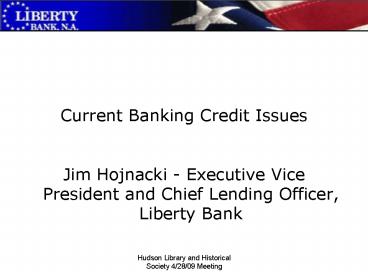Current Banking Credit Issues - PowerPoint PPT Presentation
1 / 10
Title:
Current Banking Credit Issues
Description:
Government has invested in preferred shares of large banks and is initiating the ... Massive worldwide government actions and infusion of liquidity will help. ... – PowerPoint PPT presentation
Number of Views:45
Avg rating:3.0/5.0
Title: Current Banking Credit Issues
1
- Current Banking Credit Issues
- Jim Hojnacki - Executive Vice President and Chief
Lending Officer, Liberty Bank
2
- Introduction/Agenda
- Section I Overview of Liberty Bank
- Section II State of the Economy
- Section III The Current Banking/Credit Situation
- Section IV Effect on Small Business Credit
- Section V Wrap-Up/Discussion
3
- Overview of Liberty Bank
- History/Capitalization
- Locations
- Markets Served
- Types of Lending
4
- State of the Economy
- U.S. Economy
- Has the U.S. economy suffered a recession or
depression? What are the underlying causes of
the economy's problems? When will the housing
market find a bottom? What other financial
shoes could drop? Have oil and other commodity
prices moderated? Just how decoupled is the
global economy from the U.S.? Is credit
available to businesses and consumers? - World Economy
- Just how decoupled is the global economy from
the U.S.?
5
- New data show the U.S. economys troubles
deepening, with nonfarm payroll declining sharply
in March reaching their highest level since the
2001 recession and factory orders tumbling
sharply. - Unemployment rate rose from 8.1 to 8.5.
- Since the recession began in December, 2007, 5.1
million jobs have been lost, with almost
two-thirds (3.3 million) of the decrease
occurring in the last five months (source U.S.
Labor Department). - According to the IMF, the world economy is now
expected to experience slower growth. The 2009
forecast was slashed from 3.9 to 3, which would
be the weakest level since 2002 and around the
threshold of what the IMF considers a global
recession.
6
- Bruce Bittles, chief investment strategist at
R.W. Baird, writes - The combination of falling home values and a drop
in mortgage rates will dramatically improve
housing affordability and along with plunging
energy prices improve consumer discretionary
income. This is the first step in the recovery
process that is expected to stabilize the economy
by mid-2009. - April 28 (Bloomberg) -- Consumer confidence in
the U.S. jumped by the most since 2005 this month
as stocks rallied, mortgage rates dropped and
Americans anticipated more jobs would become
available. There certainly is starting to be a
shift here, where the data is either less bad or
even starting to improve, according to Michael
Darda, chief economist at MKM Partners LP in New
York. While we certainly havent turned the
corner yet the economy could bottom out between
June and October of this year and then start
growing.
7
- The Current Banking Situation
- Significant write-downs and capital erosion.
- Increased rate of bank failures (e.g.- IndyMac,
etc.). FDIC presently has over 100 banks on its
Watch List. - Some banks have exited certain lending segments
(e.g. construction and student lending) and
tightened lending standards. Many loans
downgraded. - Those institutions with weaker capital positions
are cutting back on lending and/or seeking to
raise capital. - Well capitalized institutions are increasing
market share as other banks are pulling back.
Many community banks are increasing lending
activities. - Government has invested in preferred shares of
large banks and is initiating the purchase
illiquid securities. - Temporary increase in FDIC insurance limits
through 12/31/09.
8
- Effects on Small Business Credit
- Certain types of credit less available (e.g.
unsecured, etc.). - Credit standards tightened (e.g.- higher credit
scores, larger capital requirements, evidence of
ability to service debt based upon historic cash
flow, shorter amortization periods, stronger
guarantees, etc.). - Higher rates and fees resulting from greater
pricing for risk and higher levels of loan loss
reserves. - Requirement of additional sources of repayment
(e.g. SBA guarantees). - Credit freeze has negatively impacted business
and created the need for stronger capital bases,
well documented business plans and solid cash
flow as a means of demonstrating repayment
ability.
9
- Outlook
- Rough ride expected for economy through 2009.
- Continued deleveraging of corporate and personal
balance sheets. - U.S. government infusion of capital into banks
and purchase of illiquid securities will help
instill confidence. - Coordinated efforts to reduce interest rates will
aid businesses and consumers. - Massive worldwide government actions and infusion
of liquidity will help. - 2009 Recovery Act provisions will provide for (i)
improvement in the secondary market for 7(a) and
first lien 504 loans (ii) temporary increase in
SBA guarantee levels and (iii) temporary
elimination of certain SBA fees for borrowers and
third party lender. - New business formation and wealth creation
opportunities.
10
(No Transcript)































